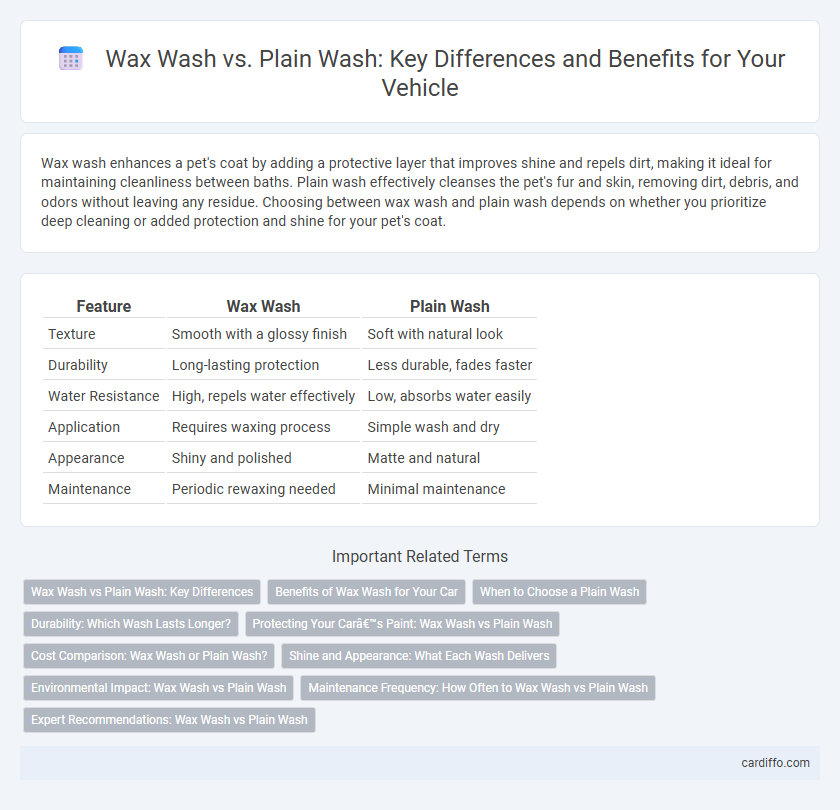Wax wash enhances a pet's coat by adding a protective layer that improves shine and repels dirt, making it ideal for maintaining cleanliness between baths. Plain wash effectively cleanses the pet's fur and skin, removing dirt, debris, and odors without leaving any residue. Choosing between wax wash and plain wash depends on whether you prioritize deep cleaning or added protection and shine for your pet's coat.
Table of Comparison
| Feature | Wax Wash | Plain Wash |
|---|---|---|
| Texture | Smooth with a glossy finish | Soft with natural look |
| Durability | Long-lasting protection | Less durable, fades faster |
| Water Resistance | High, repels water effectively | Low, absorbs water easily |
| Application | Requires waxing process | Simple wash and dry |
| Appearance | Shiny and polished | Matte and natural |
| Maintenance | Periodic rewaxing needed | Minimal maintenance |
Wax Wash vs Plain Wash: Key Differences
Wax wash creates a shiny, slightly stiff finish on fabric by coating fibers with wax, enhancing water resistance and durability. Plain wash softens fabric through basic washing techniques, resulting in a more natural, matte texture without added protective layers. The key difference lies in wax wash providing a glossy, protective surface, while plain wash emphasizes softness and breathability.
Benefits of Wax Wash for Your Car
Wax wash provides a protective layer that repels dirt and water, reducing the frequency of car washes and preserving the vehicle's paint finish. Unlike plain washes, wax washes enhance the car's shine, maintaining a glossy appearance that helps resist fading from UV exposure. This treatment also minimizes the risk of scratches and swirl marks during cleaning, extending the overall lifespan of the car's exterior.
When to Choose a Plain Wash
Choose a plain wash when seeking a clean, minimalistic look that highlights the natural color and texture of the fabric without added effects. Plain washes maintain the garment's original durability and are ideal for business casual or classic styles that require a polished appearance. Opt for plain wash jeans or shirts when simplicity and versatility are priority for everyday or professional wear.
Durability: Which Wash Lasts Longer?
Wax wash enhances fabric durability by embedding a protective coating that resists wear and tear better than plain wash. Plain wash softens garments through basic laundering, which can weaken fibers over time, reducing lifespan. Studies show wax wash-treated textiles maintain structural integrity up to 30% longer, making them ideal for high-use apparel.
Protecting Your Car’s Paint: Wax Wash vs Plain Wash
Wax wash provides a protective layer that helps shield your car's paint from dirt, UV rays, and minor scratches, extending the vehicle's exterior lifespan. Plain wash removes surface contaminants but lacks the protective coating that wax offers, leaving paint more vulnerable to environmental damage. Regular use of wax wash enhances paint durability and maintains a glossy finish, making it the preferred choice for long-term car care.
Cost Comparison: Wax Wash or Plain Wash?
Wax wash typically costs more than plain wash due to the additional materials and labor involved in applying the protective wax coating. Plain wash offers a budget-friendly cleaning option without the enhanced durability and shine provided by wax treatments. Choosing between wax wash and plain wash depends on whether the added cost aligns with the desire for longer-lasting cleanliness and vehicle protection.
Shine and Appearance: What Each Wash Delivers
Wax wash produces a glossy, polished shine that enhances fabric richness and depth, giving garments a sleek, vibrant appearance. Plain wash offers a softer, matte finish that highlights natural fabric textures while maintaining a more muted, classic look. Choosing between wax wash and plain wash depends on the desired level of shine and the intended visual impact on the clothing.
Environmental Impact: Wax Wash vs Plain Wash
Wax wash treatments use chemical coatings that can introduce non-biodegradable substances into water systems, increasing environmental pollution compared to plain wash methods. Plain wash relies primarily on water and mild detergents, which generally have a lower ecological footprint and are more easily biodegradable. Studies show that reducing chemical use in garment processing significantly decreases water contamination and energy consumption, promoting more sustainable textile production.
Maintenance Frequency: How Often to Wax Wash vs Plain Wash
Wax wash typically requires maintenance every 4 to 6 weeks due to the protective wax coating that helps repel dirt and water, extending the interval between washes. Plain wash demands more frequent cleaning, often every 1 to 2 weeks, as it lacks the protective barrier and allows grime to accumulate faster. Choosing wax wash reduces the overall wash frequency and helps maintain a cleaner surface for a longer period.
Expert Recommendations: Wax Wash vs Plain Wash
Experts recommend wax wash for preserving the fabric's natural oils and enhancing water repellency, making it ideal for outdoor garments and leather items. Plain wash effectively removes dirt and sweat without adding any protective layer, suitable for everyday clothes that require regular cleaning. Choosing between wax wash and plain wash depends on garment type and intended use, with wax wash favored for durability and protection.
Wax Wash vs Plain Wash Infographic

 cardiffo.com
cardiffo.com